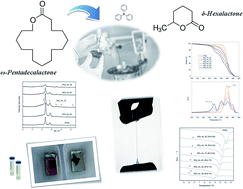Synthesis and properties of ω-pentadecalactone-co-δ-hexalactone copolymers: a biodegradable thermoplastic elastomer as an alternative to poly(ε-caprolactone)†
Abstract
The copolymerization of ω-pentadecalactone with the little-known δ-hexalactone, a cyclic ester with an identical structure to δ-valerolactone but possessing a methyl pendant group, creates a new kind of low glass transition polyester that shows improved biodegradability in comparison to poly(ε-caprolactone) (PCL). The poly(ω-PDL-co-δ-HL), with ω-PDL molar contents ranging from 39 to 82%, were synthesized using triphenyl bismuth as catalyst and presented a chain microstructure that deviated slightly from a random distribution (R > 0.74) while WAXS measurements proved that only the ω-PDL blocks were able to crystallize. Therefore, the incorporation of δ-HL decreased the crystalline fraction of the poly(ω-pentadecalactone) to 21–44% and the Tms of the copolymers shifted from 104 °C to temperatures between 53 and 88 °C. On the other hand, the low glass transition temperatures (<−36 °C) of these thermoplastic elastomers allow a rapid crystallization from melt, which prevents physical aging during their storage or application. The degradation rates obtained for the poly(ω-PDL-co-δ-HL), after carrying out in vitro degradation studies in phosphate buffer solution (at 37 °C for 182 days), ranged from 0.0013 to 0.0019 d−1. Thermogravimetric analysis also demonstrated their great thermal stability, since they were completely degraded at temperatures close to 500 °C. These ω-PDL-co-δ-HL copolymers displayed tunable mechanical properties, adjusted according to their composition, with lower elastic modulus values than PCL and a mechanical performance that was quite steady at both room temperature (21 °C) and body temperature (37 °C).


 Please wait while we load your content...
Please wait while we load your content...